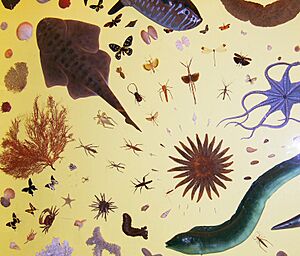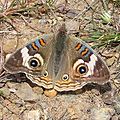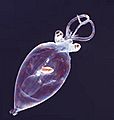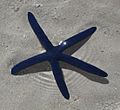Symmetry (biology) facts for kids
Symmetry in biology is all about the shape of a living thing and how its parts are arranged. Most multicellular organisms, which are creatures made of many cells, have some kind of balanced shape. This balance is called symmetry. The main types are radial symmetry, bilateral symmetry, or spherical symmetry. A few living things have no symmetry at all; they are called asymmetric.
In nature, perfect symmetry is rare. For example, if you fold a plant leaf in half, the two sides might look very similar, but they usually won't match up perfectly.
Contents
What Are the Main Types of Symmetry?
There are three basic ways living things can be symmetrical:
Radial Symmetry
Imagine a pie or a pizza. An organism with radial symmetry is like that pie. You can cut it into several roughly identical pieces that all spread out from a central point. Think of a starfish or a sea anemone.
Bilateral Symmetry
This is the most common type of symmetry you see in animals, including humans! If an organism has bilateral symmetry, it means you can draw an imaginary line down its middle, and both sides will look almost exactly the same. Butterflies, fish, and most mammals are good examples.
Spherical Symmetry
This type of symmetry is found in organisms that are shaped like a perfect ball. If you cut through the center of a spherically symmetrical organism in any direction, the two halves will look the same. Some tiny, single-celled organisms like the alga Volvox have this shape.
What Is Asymmetry?
Asymmetry means that an organism does not have a balanced shape. It doesn't have any clear lines or points where you can divide it into matching halves. Some sponges and slime moulds are examples of living things that are asymmetric.
Images for kids
-
The patterns on the wings of butterflies are one example of bilateral symmetry.
-
This cephalopod from plankton shows bilateral symmetry.
-
A starfish has radial symmetry.
-
Slime mold is asymmetric.
-
Volvox is a microscopic green freshwater alga with spherical symmetry. Young colonies can be seen inside the larger ones.
-
These sea anemones have been painted to emphasize their radial symmetry. (Plate from Ernst Haeckel's Kunstformen der Natur).
-
Gastroenteritis viruses have radial symmetry, being icosahedral: A rotavirus, B adenovirus, C norovirus, D astrovirus.
-
The small emperor moth, Saturnia pavonia, displays a deimatic pattern with bilateral symmetry.
See also
 In Spanish: Simetría bilateral para niños
In Spanish: Simetría bilateral para niños














